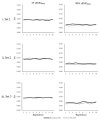Residual Force Enhancement Is Present in Consecutive Post-Stretch Isometric Contractions of the Hamstrings during a Training Simulation
- PMID: 33525530
- PMCID: PMC7908171
- DOI: 10.3390/ijerph18031154
Residual Force Enhancement Is Present in Consecutive Post-Stretch Isometric Contractions of the Hamstrings during a Training Simulation
Abstract
Residual force enhancement (rFE) is observed when isometric force following an active stretch is elevated compared to an isometric contraction at corresponding muscle lengths. Acute rFE has been confirmed in vivo in upper and lower limb muscles. However, it is uncertain whether rFE persists using multiple, consecutive contractions as per a training simulation. Using the knee flexors, 10 recreationally active participants (seven males, three females; age 31.00 years ± 8.43 years) performed baseline isometric contractions at 150° knee flexion (180° representing terminal knee extension) of 50% maximal voluntary activation of semitendinosus. Participants performed post-stretch isometric (PS-ISO) contractions (three sets of 10 repetitions) starting at 90° knee extension with a joint rotation of 60° at 60°·s-1 at 50% maximal voluntary activation of semitendinosus. Baseline isometric torque and muscle activation were compared to PS-ISO torque and muscle activation across all 30 repetitions. Significant rFE was noted in all repetitions (37.8-77.74%), with no difference in torque between repetitions or sets. There was no difference in activation of semitendinosus or biceps femoris long-head between baseline and PS-ISO contractions in all repetitions (ST; baseline ISO = 0.095-1.000 ± 0.036-0.039 Mv, PS-ISO = 0.094-0.098 ± 0.033-0.038 and BFlh; baseline ISO = 0.068-0.075 ± 0.031-0.038 Mv). This is the first investigation to observe rFE during multiple, consecutive submaximal PS-ISO contractions. PS-ISO contractions have the potential to be used as a training stimulus.
Keywords: electromyography; hamstrings; history dependence; in vivo; muscle; residual force enhancement; training simulation.
Conflict of interest statement
The authors declare no conflict of interest.
Figures



Similar articles
-
Maximal and submaximal isometric torque is elevated immediately following highly controlled active stretches of the hamstrings.J Electromyogr Kinesiol. 2021 Feb;56:102500. doi: 10.1016/j.jelekin.2020.102500. Epub 2020 Nov 16. J Electromyogr Kinesiol. 2021. PMID: 33242749
-
Poststretch Isometric Contractions of the Hamstrings: Just a Brief Stretch to Achieve Supramaximal Isometric Force.J Appl Biomech. 2021 Aug 1;37(4):320-326. doi: 10.1123/jab.2020-0236. Epub 2021 Jul 16. J Appl Biomech. 2021. PMID: 34271550
-
Residual force enhancement during voluntary contractions of knee extensors and flexors at short and long muscle lengths.J Biomech. 2012 Apr 5;45(6):913-8. doi: 10.1016/j.jbiomech.2012.01.026. Epub 2012 Feb 20. J Biomech. 2012. PMID: 22356842 Clinical Trial.
-
Fatigue-induced changes in hamstrings' active muscle stiffness: effect of contraction type and implications for strain injuries.Eur J Appl Physiol. 2023 Apr;123(4):833-846. doi: 10.1007/s00421-022-05104-0. Epub 2022 Dec 10. Eur J Appl Physiol. 2023. PMID: 36494585 Free PMC article.
-
Hamstrings force-length relationships and their implications for angle-specific joint torques: a narrative review.BMC Sports Sci Med Rehabil. 2022 Sep 5;14(1):166. doi: 10.1186/s13102-022-00555-6. BMC Sports Sci Med Rehabil. 2022. PMID: 36064431 Free PMC article. Review.
References
-
- Green B., Bourne M.N., Van Dyk N., Pizzari T. Recalibrating the risk of hamstring strain injury (HSI): A 2020 systematic review and meta-analysis of risk factors for index and recurrent hamstring strain injury in sport. Br. J. Sports Med. 2020;54:1081–1088. doi: 10.1136/bjsports-2019-100983. - DOI - PubMed
MeSH terms
LinkOut - more resources
Full Text Sources
Other Literature Sources

